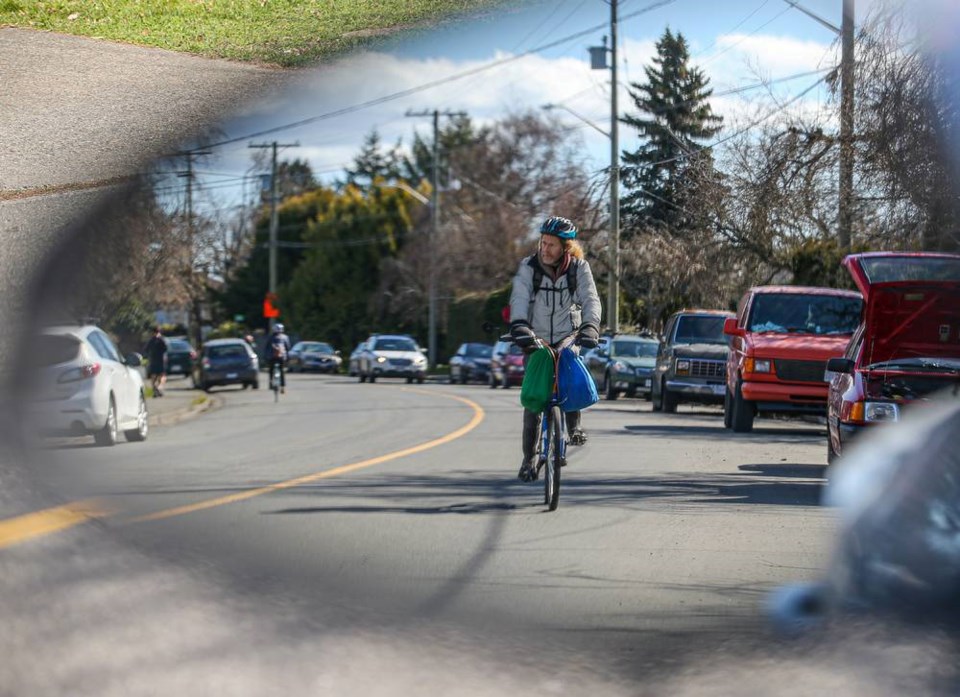A commentary by a retired transportation planner and a long-time transit, cycling and road-safety advocate who has lived on McNeill Avenue for 42 years.
The disruption of blocking off vehicle traffic on Richardson Street in Fairfield is far greater than the benefit of the three-kilometre AAA bike route.
The City of Victoria’s approved plan for Richardson will eliminate all continuous east-west vehicle travel from Cook Street to Foul Bay Road.
After camps in parks and Clover Point, it might become the next contentious issue in Victoria. It threatens to disrupt the entire residential area bounded by Cook Street, Fairfield Road, Foul Bay Road, Oak Bay Avenue, and Rockland Avenue. It is a perfect example of a “solution” in search of a problem.
Richardson is designated as a Local Collector street in the City’s own bylaws and is a direct and valuable east-west access road for all residents.
It has successfully and safely accommodated all road users for the past 75 years. The section from Durban Street to Foul Bay Road is one of the widest and flattest streets in Victoria with ample on-street parking, two lanes of traffic and room for cyclists to share those two lanes. Cook to Moss Street is narrower and poses the biggest challenge.
Other designs with less infrastructure and more training for cyclists could also improve cycling safety and minimize neighbourhood disruption. Essentially, there is no problem on this street and there never has been.
No neighbourhood consultation was ever done regarding changing the street’s official designation. In fact, the Richardson plan was hastily approved in early July 2020 when residents were distracted by the Canada Day long weekend, summer and the ongoing pandemic.
Very few residents are even aware of the impending bike-lane construction project that is about to change their neighbourhood forever and impact every future trip they will make.
The plan will see traffic diverters preventing vehicles from continuing east or west at four locations along Richardson. This will force Richardson’s nearly 4,000 daily vehicle trips to divert onto adjacent quiet residential streets to access Fairfield Road, Rockland Avenue, or Oak Bay Avenue. This increased traffic will significantly compromise safety on those ordinarily quiet streets.
This affects more than just residents. It is going to impact police, ambulance, fire, transit, taxis, recycling and garbage trucks, delivery and service companies, children going to school and all visitors to the area. I wonder what those agencies said during consultation, assuming they were all consulted.
Westbound vehicles on McNeill Avenue in South Oak Bay will now have to turn left or right at Foul Bay Road. A majority will turn right and then 30 metres later turn left onto Quamichan Street to go 600 metres to Richmond Road to access Oak Bay Avenue and downtown.
The City installed five speed humps on Quamichan 20 years ago to discourage using this shortcut. Quamichan residents can expect a significant increase in traffic thanks to the Richardson Plan.
Fairfield Road already has enough traffic. There are two schools, parks, and a shopping centre. Diverting even more traffic onto this winding road is unwelcome, unnecessary and ill-advised. Similarly, Oak Bay Avenue is already busy enough. The most logical route is the Local Collector street we already have, the street with no issues, namely Richardson.
A Richardson user driving downtown from Oak Bay can expect a five- to seven-minute longer trip (as reported in the TC). More fuel will be burned, more GHG emissions produced and more time wasted.
An environmental audit would likely show that the bike lane plan created more congestion, more pollution and more vehicle kilometres driven than any offsetting positive benefits derived from attracting any number of new cyclists.
The proposed traffic diverter at Richardson and St. Charles will result in many drivers who want to continue along Richardson turning onto St. Charles, making a U-turn by pulling into a driveway to go back to the intersection and turn back onto Richardson. I doubt that anyone who lives within a block of Richardson will welcome this new reality. They are liable to be furious once they realize what the city is doing to them.
Oak Bay, east of Foul Bay Road, has fewer residents today than 40 years ago. And today’s residents are older. So much for a large new cycling audience. Will Oak Bay continue the bike lane on McNeill Avenue? Not on your life. There is a greater chance that they post signs warning motorists that they are about to enter the City of Victoria.
If these unintended negative consequences in the city’s approved plan cannot be further mitigated, then council should consider purchasing rose-coloured sunglasses for every resident to make the bike lane plan at least appear more attractive. And better order them by the thousands, not hundreds.
The Richardson bike lane plan is on the City of Victoria’s website. Every resident of Fairfield, Gonzales, Rockland and South Oak Bay should read it.



